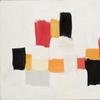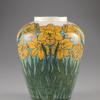INDIAN AND SOUTHEAST ASIAN ART ASTOUNDS AT CHRISTIE’S IN SEPTEMBER
- NEW YORK, New York
- /
- September 05, 2012
On September 12, Christie’s will present the sale of Indian and Southeast Asian Art, featuring over 120 lots of rarity and significance from Gandhara, Nepal, Tibet and India. The sale’s highlights include a polychromed gray schist figure of the Teaching Buddha, a gilt bronze Padmapani, and two important early thangkas from the Collection of Dr. Eugenio Ghersi. Born in Oneglia, Italy in 1904, Dr. Ghersi was a brilliant surgeon, naval hero, and one of the last great explorers of Tibet.
Over the course of two expeditions with Giuseppe Tucci between 1933-35, he meticulously photographed and documented numerous monuments and artworks in the Himalayas, which were under constant threat of being replaced by new commissions or falling into disrepair. Their elaborate records and research served as the basis for several publications by Tucci.
A highly important thangka of Amitabha is among the highlights from the Collection of Dr. Eugenio Ghersi. Painted in Western Tibet in the second half of the 13th century, likely commissioned as an act of devotion to the holy lamas, this thangka depicts the Buddha seated on a double-lotus throne over a lion base (estimate: $400,000-600,000). Unlike most representations of Amitabha, this thangka has replaced the customary peacocks that support his throne with lions, indicating that perhaps this is from a set of five paintings of the Five Buddhas. Above Amitabha, there are 127 Buddhas arranged by color in a chevron pattern and, in the bottom register, the lineage teachers are identified by inscription. Among those portrayed is Atisha, the Indian master who came to Tibet in 1042 to renew the teaching and practice of Buddhism, making this thangka one of the earliest known depictions of Atisha and possibly the first identifying him by inscription.
Also from the Collection of Dr. Eugenio Ghersi is an impressive thangka of the Green Tara (estimate: $400,000-600,000). The Green Tara is portrayed alongside the Five Buddhas, the Twenty-one Taras of the Suryagupta tradition, and the Eight Taras Removing the Eight Fears, making this the earliest example of the Green Tara in association with Twenty-one Taras and the Eight Fears. This and the thangka of Amitabha have remained in the same condition since acquired by Dr. Ghersi in 1933.
From a private collection, a gilt bronze Padmapani depicts Avalokiteshvara, the bodhisattva of compassion and one of the principal deities in Mahayana Buddhism (estimate: $200,000-300,000). With exquisite sculptural detailing, he is adorned with ornate jewelry as he delicately grasps the stem of a lotus blossom.
A superb large gray schist figure of a standing Buddha will also be offered in the sale (estimate: $400,000-600,000). With the growing popularity of Mahayana Buddhism around the 2nd century, large detached images were sculpted alongside narrative friezes. This sculpture of a standing Buddha is characteristic for the high point of Gandharan art, among the very best in terms of refinement in carving and in an excellent state of preservation.
An important parcel gilt and polychromed gray schist figure of the Teaching Buddha is among the sale’s highlights, executed in Gandhara in the 2nd/3rd century (estimate: $400,000-600,000). The very finely carved work is inspired by a tale in which Buddha performed eight miracles to demonstrate his superiority over the Kasyapas; the scene depicted here is of the second of these miracles. Two serpent (naga) kings created a lotus, upon which the Buddha sat and, by supernatural power, created multiple images of himself. The artist has reduced the scene to its most basic components in an abstracted representation, taking advantage of the linguistic pun, in which naga denotes both elephant and serpent, and portraying the lotus as being supported by two elephants with rather serpentine trunks. Impressively, this figure of Buddha retains much of the original gilding, serving as one of the few remaining polychromed schist figures.




10270x400_c.jpg)

















